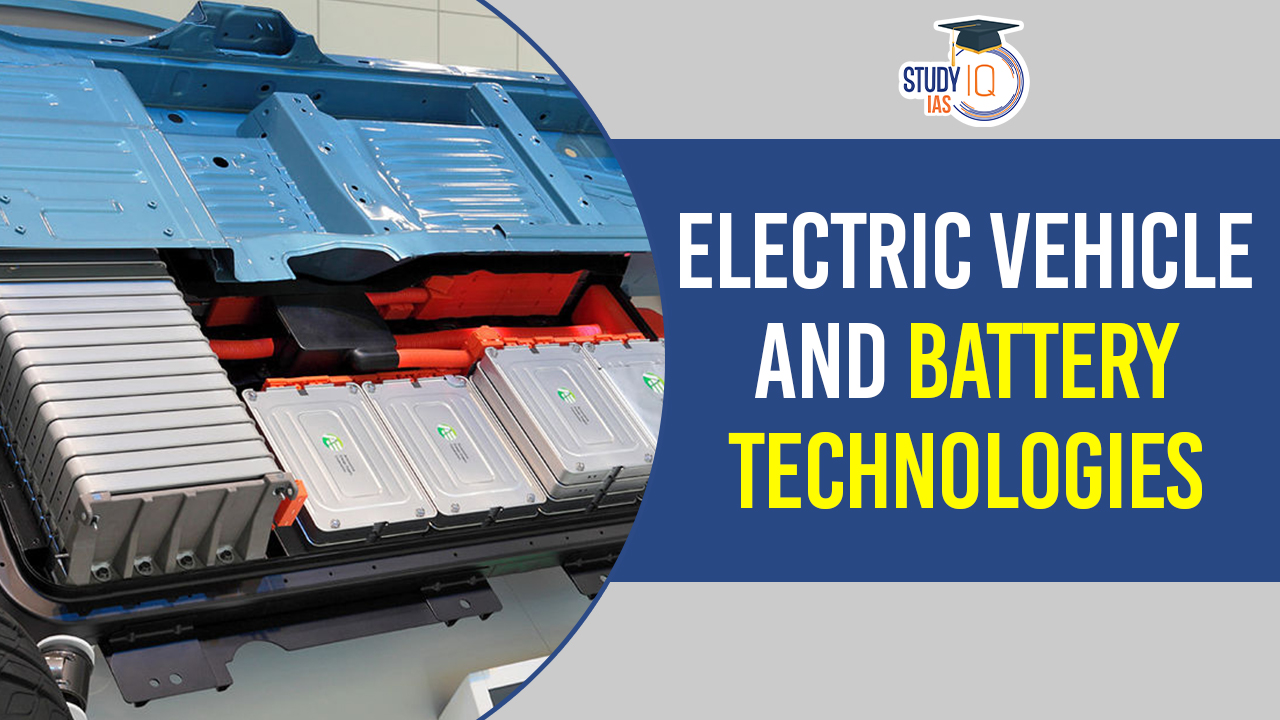Table of Contents
Context: The projected growth of the Indian Electric Vehicle (EV) market is dependent on advances in battery technology translating to better economics and enhanced user experience. However, despite advancements, current Li-ion batteries still have significant room for improvement.
Lithium Ion Batteries in Electric Vehicles (EVs)
Functioning
- It consists of two electrodes (anode & cathode) separated by a liquid electrolyte.
- Lithium atoms in the anode give up electrons which travel to the cathode through an external wire — this stream of electrons provides the current which powers the motor of the vehicle.
- Simultaneously, lithium ions (now positively charged from loss of an electron) travel through the electrolyte to reach the cathode.
- During charging, the process is reversed with lithium ions being forced to travel back through the electrolyte to the anode.
Advantages
- Lithium is the lightest element, readily releasing electrons.
- Enables lighter, smaller batteries with high energy storage.
Disadvantages
- Energy density is lower than petrol.
- Slow charging speeds compared to refuelling.
- High cost and limited lifespan.
- Environmental concerns about mining materials like lithium and cobalt.
We’re now on WhatsApp. Click to Join
|
Facts |
|
Improving Electric Vehicles Batteries: Approaches
Refining Lithium-Ion
- Focus on electrode materials:
- Lightweight with high lithium storage capacity.
- Efficient lithium pathways for faster charging and higher voltage.
- Affordable, non-toxic, and readily available materials.
- Trade-offs exist:
- Nickel-Manganese-Cobalt (NMC) (Tesla): high energy density, longer range, less stable.
- Lithium Iron Phosphate (LFP) : longer life, faster charging, less toxic, less range.
Solid-State Lithium Batteries (SSBs):
- Replaces liquid electrolyte with heat resistant lightweight solid electrolyte, improving stability and safety.
- Potential for EVs with longer range, higher energy density, faster charging, and wider temperature tolerance.
- Challenges: material cost, production scalability, dendrite growth.
Beyond Lithium:
- Explore alternative battery chemistries like sodium-ion, magnesium-ion, or lithium-sulphur.
- Potential for lower cost, wider resource availability, and higher energy density.
- Early stage development, challenges with performance and stability.
Improving Battery Management Systems (BMS)
- Enhance safety, lifespan, and charging speed through sensors, control circuitry, and algorithms.
- Monitors temperature, voltage, and current to optimise charging and prevent damage.
- Easier to implement than changing battery chemistry.
|
UPSC Mains Question |
| Q. The adoption of electric vehicles is rapidly growing worldwide. How do electric vehicles contribute to reducing carbon emissions and what are the key benefits they offer compared to traditional combustion engine vehicles? (PYQ UPSC – 2023) |


 Operation Baam: Baloch Separatist Group ...
Operation Baam: Baloch Separatist Group ...
 Genetically Modified Crops in India, Reg...
Genetically Modified Crops in India, Reg...
 National Register of Indian Citizens (NR...
National Register of Indian Citizens (NR...





















